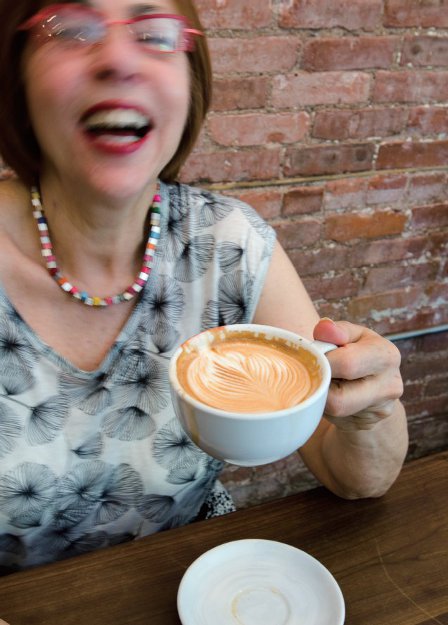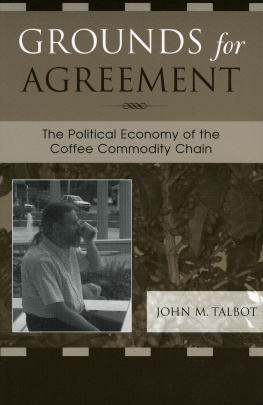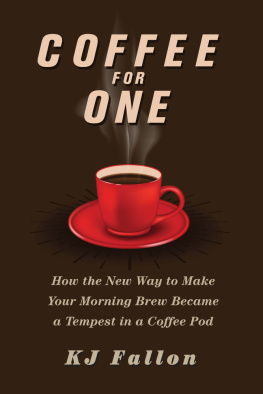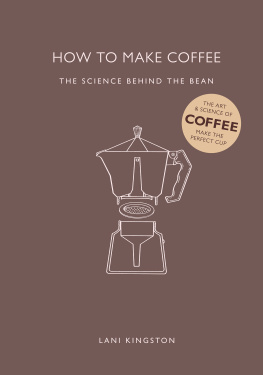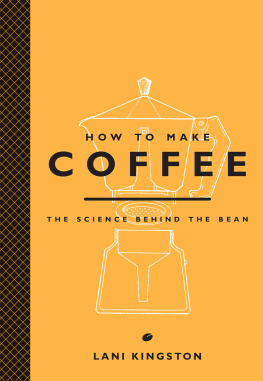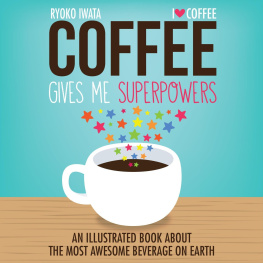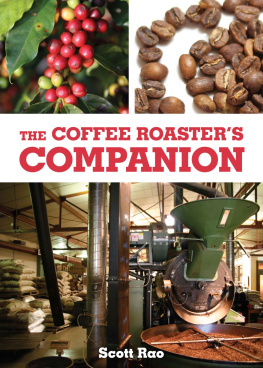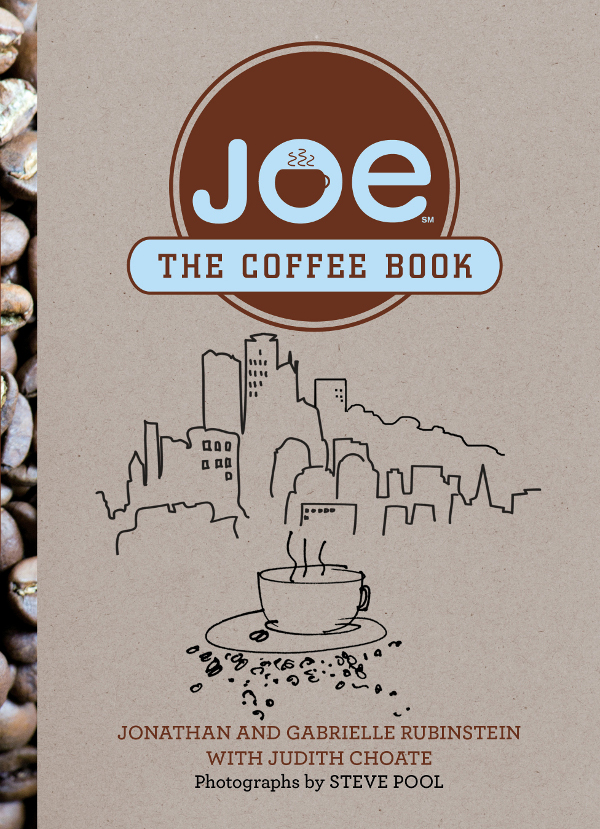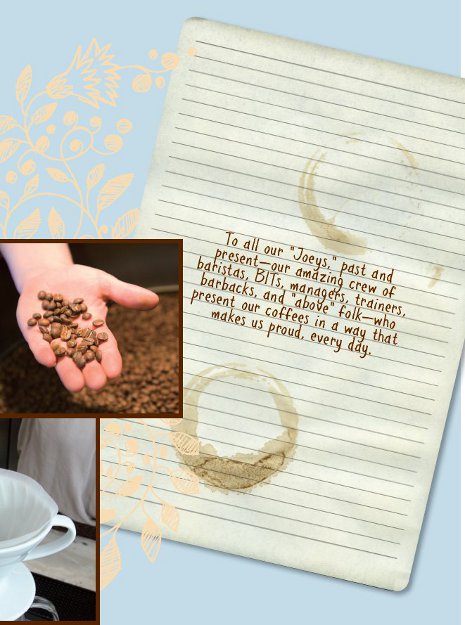ALL RIGHTS RESERVED. No part of this book may be reproduced or transmitted in any form by any means, electronic or mechanical, including photocopying and recording, or by any information storage and retrieval system, except as may be expressly permitted in writing from the publisher. Requests for permission should be addressed to Globe Pequot Press, Attn: Rights and Permissions Department, PO Box 480, Guilford, CT 06437.
Lyons Press is an imprint of Globe Pequot Press.
Photographs in Chapter 1 by Amanda Byron, with the exception of cup image on page 2 Steve Pool and branch image on page 9 licensed by Shutterstock.com. All other images Steve Pool.
Library of Congress Cataloging-in-Publication Data is available on file.
T here are so many people who have been instrumental in making this book happen. First and foremost, our Vice President and Director of Coffee, our first employee, the Other author of this book, and the Other Rubinstein, Amanda Byron. She is the great unsung hero of joe , the voice of reason, a woman of vision, and the one who constantly brings us back to our mission of great coffee.
Thanks to our parents, Richard and Alice Rubinstein, without whom joe wouldnt exist. They give us roots and wings every day and allow us to steer the ship as we see fit.
Thanks to our friends at Ecco Caff, most specifically Andrew Barnett, Doug Zell, Amber Fox, David Latourell, Steve Mierisch, and Ramin Narimani for taking such great care of us and for all your help and guidance with the text.
Thanks to Michael and Ben and First Press for helping to make people aware of what we do.
Thanks to Barth and Gregg and everyone at Barrington Coffeeour first partners and a constant source of inspiration. Thanks to Mary Norris and David Legere of Lyons Press as well as Grainne Fox and Christy Fletcherour supportive and hard working team of editors and agents who made this beautiful book a reality. And thanks to Steve Poole and Judith Choate for coming up with the idea of this book and for more than just a wee bit of the work in making it happen.
Most importantly, to our amazing group of managers, educators, and baristas, who serve our coffee to the people there are too many of you to name individually, but we are blessed to have your culinary skill, and your warmth and integrity. Thank you for making us and our customers happy, one cup at a time.
H ow many times have you heard someone say, Id like a nice, hot cup of coffee!? (I know, I know, it really should be a nice cup of hot coffee, but nobody ever says that!) In our family, it was my mom, Alice, who was forever on the quest, not for a nice cup of hot coffee but for the perfectly made latte. For years, she was obsessive, going from coffee shop to coffeehouse to bistro to trattoria scouting out that elusive cup. Shed order, sip, grimace, and move on. Moms infatuation became a family joke, but we were so often on the trail together that her passion lured the rest of us deep into latte-land. We all joined in the chase for the perfect cup.
What had been our in-house gag turned into a serious venture when I found myself (joyfully) unemployed and thinking about changing careers. I had always been fascinated with food and the world of hospitality, but I had no interest in cooking or opening a restaurant. Besides, New York City, my home, had an excess of world-renowned dining and drinking establishments, and frankly, I didnt think that I knew enough about the restaurant business to make an impact in this mecca of all things culinary. But, interestingly, back in 2002 New York City didnt have one great coffee bar, a place where people could socialize, ponder, read, advocate for change, or just sit back and relax, all the while enjoying a matchless cuppa joe. So, coffee moved to the top of my career-change list, and along with my sister, Gabrielle, and my parents, Alice and Richard, the hunt for the perfectly made latte became a search for a perfect coffee bar of our own.

Unfortunately, none of us knew much about how to accomplish our dream bar. We knew little about the when, where, and how of great coffee, except that we seemed inherently to know it when we tasted it. We did know a bit about real estate and had a clear idea about the kind of location and coffee bar we wanted. It was Gabrielle who made the first connection to the long line of serendipitous links that created our first joe .

Apprenticing as an opera singer at the Tanglewood Music Center in the Berkshire Hills of Massachusetts, Gabby discovered the elusive cup at Lenox Coffee, owned by a partner at Barrington Coffee Roasting Company in Great Barrington. Not only did she find great coffee, but she also discovered the Barrington owners, Barth Anderson and Gregg Charbonneau. They stood right on the cutting edge of the third wave of coffee, using select beans and roasting them in-house. At Gabbys urging, we made the trip to the Berkshires, not to hear her sing, but to sip, sip, sip. Barth and Gregg became our mentors, introducing us to some of the history of coffee, the necessities of a great cup, and the people who would help us bring our own style of coffee bar to blas New Yorkers. In fact, they led us to Amanda Byron, our first employee, who had worked at their roastery. Amanda is still with us and has gone on to become vice president of our all of the joe stores.
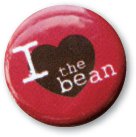
We chose Greenwich Village for our first location, mainly because of its coffeehouse history. The area had traditionally been the landmark for bohemian life in America, with new ideas, political movements, and artistic chaos emanating from its cafs, homes, and streets. Historically, the Village had been the home of writers, artists, and thinkers who gathered in the many dark, smoky coffeehouses that were the signature watering holes of the area from the early 1900s through the 1960s. Not only did art and culture thrive in the liberal atmosphere of the neighborhood coffee caf, but in the late 1950s, the off-Broadway theater was born at Caff Cino, one of the most enlightened coffeehouses of the era. Although bohemian life in the Village has given way to expensive real estate, the coffeehouse culture has prevailed, and we could think of no other area of the city in which a new style coffee bar could thrive.
